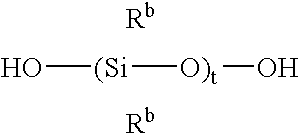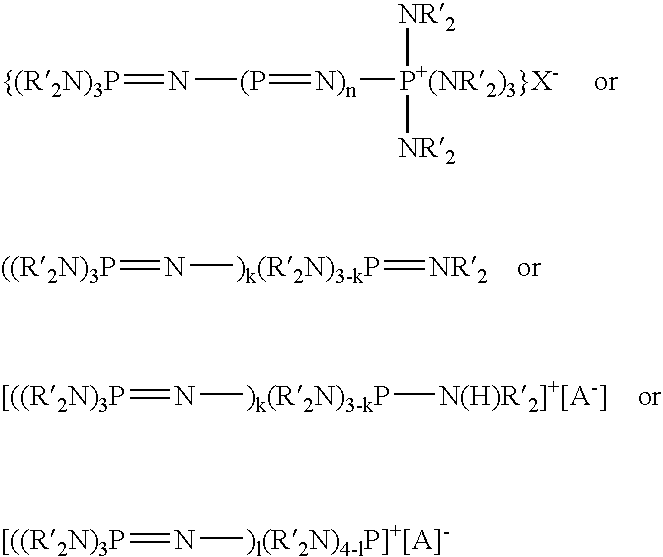Silicone release coating compositions
a technology of coating compositions and silicon ions, applied in the direction of coatings, organic chemistry, group 5/15 element organic compounds, etc., can solve the problem of adding significant cost to the formulated release coating bath, and achieve the effect of reducing the pt catalyst level and fast cur
- Summary
- Abstract
- Description
- Claims
- Application Information
AI Technical Summary
Benefits of technology
Problems solved by technology
Method used
Image
Examples
example 1
[0041] 350 g tetra(dimethylvinylsiloxy)silane and 4.65 kg D4 were mixed at 20° C. and 0.20 g polyaminophosphazenium hydroxide catalyst was admixed (40 ppm based on siloxanes), causing a rapid increase in viscosity. After a period of 30 seconds the reaction mixture was then neutralised with 25 g (0.5%) polyacrylic acid of molecular weight Mw=2000. Low molecular weight components were stripped out of the mixture and the reaction product was filtered to remove excess polyacrylic acid and neutralised catalyst. The product was a dimethylvinyl-termiinated Q-branched polysiloxane having a DP of 160 and viscosity of 220 mPa·s.
[0042] 100 g of this Q-branched polysiloxane was mixed with 3.3 g trimethyl-terminated poly(methylhydrogensiloxane) having a viscosity of 11 mPa·s and 0.8 g parts of the catalyst reaction product of chloroplatinic acid and divinyltetramethyldisiloxane (0.5% Pt; 40 ppm Pt based on siloxane) to form a release coating composition. This composition was coated on glassine ...
examples 2 to 9
[0045] Example 1 was repeated varying the temperature of preparation of the dimethylvinyl-terminated Q-branched polysiloxane and the molecular weight and amount of the polyacrylic acid used for neutralisation. The extractables of various cured release coatings were measured as described in Example 1 and are shown in Table 1 below
TABLE 1Example123456789Mw of Acid2000200020002000450000750000750000750000750000Quantity / %0.520.521.250.520.52Temperature / C202070704520207070Extractables100C / 15sces9.19.510.77.97.18.96.38.75.7115C / 15sces7.38.38.88.66.49.478.35.5
examples 10 to 12
[0046] The process of Example 6 was repeated using lower levels of the phosphazene base catalyst in preparation of the dimethylvinyl-terminated Q-branched polysiloxane. Release coatings were prepared from the resulting polymers and cured and tested as described in Example 1. The results are shown in Table 2.
TABLE 2Example101112Quantity of PhosphazineExtractables12.25 ppm10 ppm5 ppm100 C. / 15 secs12.212.39.9115 C. / 15 secs6.96.88.7
[0047] It will be seen that in all cases the release coating of the invention is more fully cured (less extractables) than the coating of the Comparative Example C1.
PUM
| Property | Measurement | Unit |
|---|---|---|
| Fraction | aaaaa | aaaaa |
| Fraction | aaaaa | aaaaa |
| Time | aaaaa | aaaaa |
Abstract
Description
Claims
Application Information
 Login to View More
Login to View More - R&D
- Intellectual Property
- Life Sciences
- Materials
- Tech Scout
- Unparalleled Data Quality
- Higher Quality Content
- 60% Fewer Hallucinations
Browse by: Latest US Patents, China's latest patents, Technical Efficacy Thesaurus, Application Domain, Technology Topic, Popular Technical Reports.
© 2025 PatSnap. All rights reserved.Legal|Privacy policy|Modern Slavery Act Transparency Statement|Sitemap|About US| Contact US: help@patsnap.com



